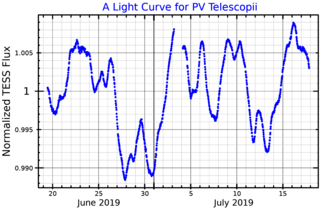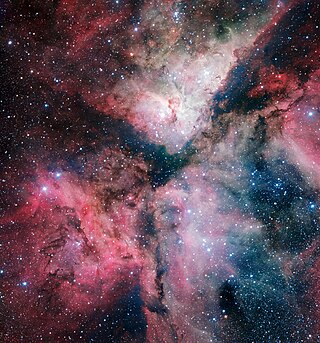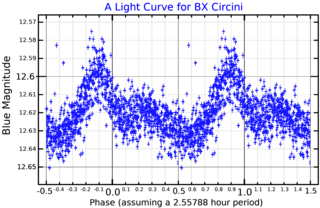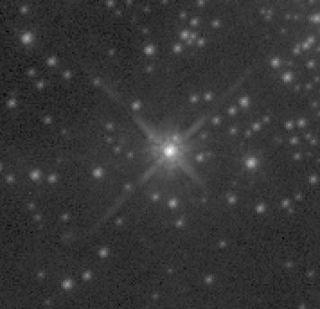
In astronomy, stellar classification is the classification of stars based on their spectral characteristics. Electromagnetic radiation from the star is analyzed by splitting it with a prism or diffraction grating into a spectrum exhibiting the rainbow of colors interspersed with spectral lines. Each line indicates a particular chemical element or molecule, with the line strength indicating the abundance of that element. The strengths of the different spectral lines vary mainly due to the temperature of the photosphere, although in some cases there are true abundance differences. The spectral class of a star is a short code primarily summarizing the ionization state, giving an objective measure of the photosphere's temperature.

Wolf–Rayet stars, often abbreviated as WR stars, are a rare heterogeneous set of stars with unusual spectra showing prominent broad emission lines of ionised helium and highly ionised nitrogen or carbon. The spectra indicate very high surface enhancement of heavy elements, depletion of hydrogen, and strong stellar winds. The surface temperatures of known Wolf–Rayet stars range from 20,000 K to around 210,000 K, hotter than almost all other kinds of stars. They were previously called W-type stars referring to their spectral classification.
A carbon star is typically an asymptotic giant branch star, a luminous red giant, whose atmosphere contains more carbon than oxygen. The two elements combine in the upper layers of the star, forming carbon monoxide, which consumes most of the oxygen in the atmosphere, leaving carbon atoms free to form other carbon compounds, giving the star a "sooty" atmosphere and a strikingly ruby red appearance. There are also some dwarf and supergiant carbon stars, with the more common giant stars sometimes being called classical carbon stars to distinguish them.

R Coronae Borealis is a low-mass yellow supergiant star in the constellation of Corona Borealis. It is the prototype of the R Cor Bor class of variable stars, which fade by several magnitudes at irregular intervals. R Coronae Borealis itself normally shines at approximately magnitude 6, just about visible to the naked eye, but at intervals of several months to many years fades to as faint as 15th magnitude. Over successive months it then gradually returns to its normal brightness, giving it the nickname "reverse nova", after the more common type of star which rapidly increases in brightness before fading.

A B-type main-sequence star is a main-sequence (hydrogen-burning) star of spectral type B and luminosity class V. These stars have from 2 to 16 times the mass of the Sun and surface temperatures between 10,000 and 30,000 K. B-type stars are extremely luminous and blue. Their spectra have strong neutral helium absorption lines, which are most prominent at the B2 subclass, and moderately strong hydrogen lines. Examples include Regulus and Algol A.

Upsilon Sagittarii is a spectroscopic binary star system in the constellation Sagittarius. Upsilon Sagittarii is the prototypical hydrogen-deficient binary (HdB), and one of only four such systems known. The unusual spectrum of hydrogen-deficient binaries has made stellar classification of Upsilon Sagittarii difficult.

Type Ib and Type Ic supernovae are categories of supernovae that are caused by the stellar core collapse of massive stars. These stars have shed or been stripped of their outer envelope of hydrogen, and, when compared to the spectrum of Type Ia supernovae, they lack the absorption line of silicon. Compared to Type Ib, Type Ic supernovae are hypothesized to have lost more of their initial envelope, including most of their helium. The two types are usually referred to as stripped core-collapse supernovae.

An R Coronae Borealis variable is an eruptive variable star that varies in luminosity in two modes, one low amplitude pulsation, and one irregular, unpredictably-sudden fading by 1 to 9 magnitudes. The prototype star R Coronae Borealis was discovered by the English amateur astronomer Edward Pigott in 1795, who first observed the enigmatic fadings of the star. Only about 150 RCB stars are currently known in our Galaxy while up to 1000 were expected, making this class a very rare kind of star.
An AM Canum Venaticorum star, is a rare type of cataclysmic variable star named after their type star, AM Canum Venaticorum. In these hot blue binary variables, a white dwarf accretes hydrogen-poor matter from a compact companion star.
An extreme helium star is a low-mass supergiant that is almost devoid of hydrogen, the most common chemical element of the Universe. Since there are no known conditions where stars devoid of hydrogen can be formed from molecular clouds, it is theorized that they are the product of the mergers of helium-core and carbon-oxygen core white dwarfs.

PV Telescopii variable is a type of variable star that is established in the General Catalogue of Variable Stars with the acronym PVTEL. This class of variables are defined as "helium supergiant Bp stars with weak hydrogen lines and enhanced lines of He and C". That is, the hydrogen spectral lines of these stars are weaker than normal for a star of stellar class B, while the lines of helium and carbon are stronger. They are a type of extreme helium star.

PV Telescopii, also known as HD 168476, is a variable star in the southern constellation of Telescopium. It is too dim to be visible to the naked eye, having an apparent visual magnitude that has been measured varying from 9.24 down to 9.40. The star is the prototype of a class of objects called PV Telescopii variables. It is located at an estimated distance of approximately 23 kilolight-years from the Sun, but is drifting closer with a radial velocity of −169 km/s.

A subdwarf O star (sdO) is a type of hot, but low-mass star. O-type subdwarfs are much dimmer than regular O-type main-sequence stars, but with a brightness about 10 to 100 times that of the Sun, and have a mass approximately half that of the Sun. Their temperature ranges from 40,000 to 100,000 K. Ionized helium is prominent in their spectra. Gravity acceleration is expressed by log g between 4.0 and 6.5. Many sdO stars are moving at high velocity through the Milky Way and are found at high galactic latitudes.

WR 24 is a Wolf-Rayet star in the constellation Carina. It is one of the most luminous stars known. At the edge of naked eye visibility it is also one of the brightest Wolf Rayet stars in the sky.

An O-type star is a hot, blue-white star of spectral type O in the Yerkes classification system employed by astronomers. They have temperatures in excess of 30,000 kelvin (K). Stars of this type have strong absorption lines of ionised helium, strong lines of other ionised elements, and hydrogen and neutral helium lines weaker than spectral type B.

BX Circini is a star in the constellation Circinus. Its variability was discovered in 1995, with its apparent magnitude ranging from 12.57 to 12.62 over a period of 2 hours 33 minutes. It is currently classified as a PV Telescopii variable star, but has been put forward as the prototype of a new class of pulsating star—the BX Circini variables—along with the only other known example, V652 Herculis. This class of star is rare, possibly because this is a brief stage of stellar evolution. Its mass has been calculated to be around 40 percent that of the Sun, but the radius is a few times larger than that of the Sun. The average surface temperature is high, and has been measured at 23,390 ± 90 K using optical spectra, but 1750 K cooler if analysing it in both the visual and ultraviolet. The temperature appears to vary by 3450 K.

Melnick 34, also called BAT99-116, is a binary Wolf–Rayet star near R136 in the 30 Doradus complex in the Large Magellanic Cloud. Both components are amongst the most massive and most luminous stars known, and the system is the most massive known binary system.
WR 135 is a variable Wolf-Rayet star located around 6,000 light years away from Earth in the constellation of Cygnus, surrounded by a faint bubble nebula blown by the intense radiation and fast wind from the star. It is just over four times the radius of the sun, but due to a temperature of 63,000 K it is 250,000 times as luminous as the sun.

DY Centauri is a variable star in the constellation Centaurus. From its brightness, it is estimated to be 7000 parsecs (23000 light-years) away from Earth.
NGC 6822-WR 12 is a WN-type Wolf-Rayet star located in the galaxy NGC 6822, about 1.54 million light years away in the constellation of Sagittarius. NGC 6822-WR 12 was the first Wolf-Rayet star to be discovered in the galaxy, and is one of only four known in the galaxy.














